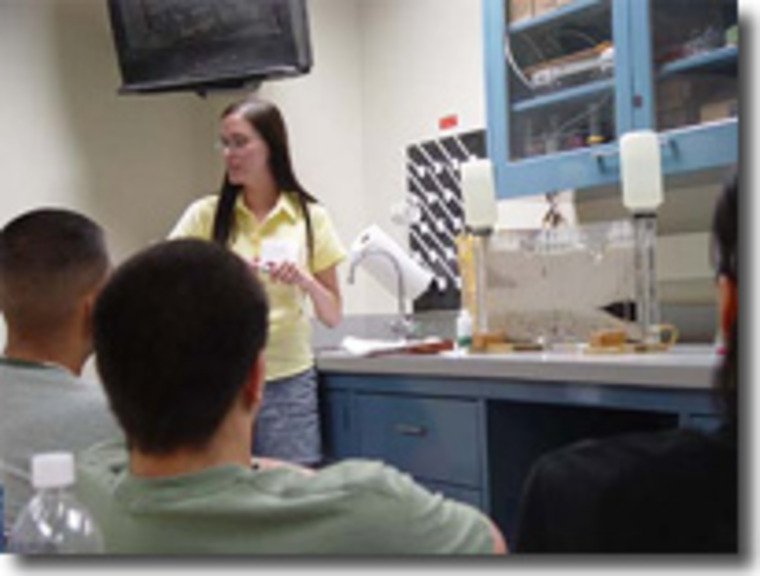Camille Holmgren

Camille Holmgren, co-sponsored by the University of Arizona Department of Geosciences
I believe one of the best ways to foster an understanding of science is to give students hands-on classroom experiences that focus on local issues. When students perform various aspects of the scientific method such as asking questions, forming hypotheses, developing and carrying out procedures, making observations, recording and analyzing data, and forming conclusions while doing lessons, they learn much more than through passive listening. Likewise, scientific concepts explored using local examples and issues can make science more meaningful to students of diverse backgrounds. Most science textbooks and activities do not, however, focus on the unique geologic features and environmental resources found in the Southwest. My science outreach goal is therefore to develop hands-on earth and environmental science lessons that focus on the Southwest and to test these in the classroom.
From 2003-2004, I served as a CATTS (Collaboration for the Advancement of Teaching Technology and Science) NSF GK-12 fellow working with the Students Across Borders Earth Science Program for Hispanic High School Students. As a CATTS fellow I have been involved in an intensive week-long summer program for students from South Tucson, Yuma, and Sonora, Mexico in addition to working with earth science classrooms on a weekly basis. Part of my experience has included developing high school earth science lessons for use in the classrooms.
For my outreach project, I have continued to work with Students Across Borders to develop earth and environmental science lessons that will be available as a resource for local teachers. In the fall of 2004, I have developed lessons focused on water resource issues and testing protocols, desert soils, erosion and deposition, dune formation and remote sensing of arid lands, minerals and mining in the Southwest, geologic hazard mapping, endangered species and development issues, solar radiation, weather mapping, and biomes in the Southwest. I have incorporated data and background information published in the scientific literature or available at agency websites (EPA, NOAA, USGS, Arizona Geological Society) into many of the lessons that I develop because I believe that using actual data can make the activity seem more “real” to students. Although some of the activities involve web-based resources, I recognize that this often increases the logistical maneuvering for a teacher when there are insufficient computers in the classroom. Thus, the lessons are primarily designed as hands-on activities that can be done in the classroom with common laboratory apparatus. By generating hands-on activities, I will provide a resource for middle and high school teachers that will impart an understanding of local issues while meeting Arizona science standards. All lessons include a list of the standards met so instructors can easily incorporate the lessons into their curriculum.
During the spring 2005, I will continue to develop curricula in addition to testing new modules in the classroom. After testing, materials will be formatted and submitted for publication in May 2004 in addition to becoming available online. These materials will provide locally-relevant curricular materials for middle and high school teachers that will allow students to become more aware of the issues in their backyard while meeting science standards. We plan to publish the materials with the hope that this will become a lasting resource for teachers and students in the Southwest.
After completing my Ph.D., I plan to seek an academic career teaching and doing research at the college/university level. I will continue research into past patterns of climate and vegetation change and will enjoy involving students in this research. I am also interested in teaching courses that will allow the students to gain an understanding of earth systems processes and how humans are affecting these systems. Given the degree to which humans are influencing global climate and ecosystems, I believe that it is vital for all students to have a basic understanding of how earth systems operate, how human actions are influencing these systems, and what choices can be made to ameliorate these effects. In particular, I would enjoy teaching courses related to introductory earth systems including Historical Geology, Physical Geology and Geography, Oceanography, Global Change, Quaternary Ecology, and Biogeography. These courses, many suitable for non-science majors, would give the future business leaders, policy makers, and voting populace the necessary understanding to make informed and responsible decisions regarding the health and well being of the planet and mankind.

